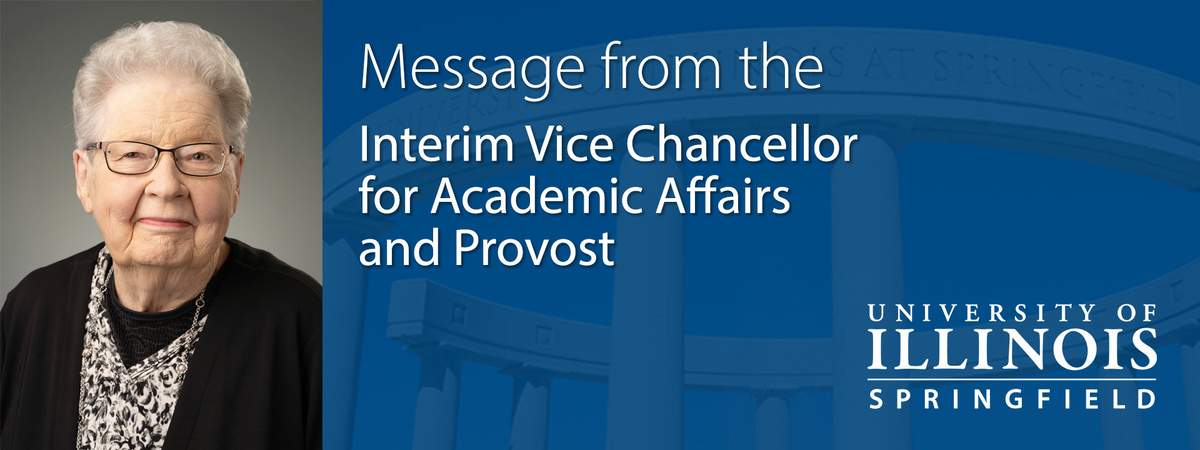Dear Faculty and Staff —
The following is a descriptive list of methods for enhancing and documenting UIS teaching effectiveness. By providing this list to colleagues on campus, I want to assure colleagues that the elements of excellence for faculty anywhere do still involve all three elements: teaching effectiveness, research and scholarly endeavors, and service activities. We know that without the vital blend of all three, there is little quality within a University faculty – it is the robust blend of the three major areas that drive faculty excellence and distinction everywhere. We also know that individuals may balance the three distinct elements differently and that the major absence of any one element detracts from the whole. However, since UIS denotes itself as a university characterized by excellence in teaching, it is vital that we reflect carefully on how we achieve and demonstrate that quality. Thus, I am providing this list of supplemental and more dynamic means of gauging teaching effectiveness for formal consideration on this campus.
This concept paper is sent with the request and hope that faculty colleagues in academic units, in collaboration with department chairs, program leads, heads, school directors and deans will engage in an appropriate review of criteria by which teaching effectiveness is determined and documented. Following that review, faculty and administrators could work together to determine and implement any necessary adjustments in practice, policy, and the requisite bylaws.
While this process may take some time, it is a worthwhile investment at an institution that proclaims World Class Teaching as a central goal. It is the senior faculty within an academic unit who determine, within the guidelines of the Faculty Personnel Policy, how and what will be used as evidence of excellence in the teaching endeavor with students.
The following list of teaching effectiveness measures (not applicable in every class) is intended to be illustrative, rather than exhaustive, of the scope of such measures – which are widely used by other institutions of higher learning. Such measures, to be fully useful, also are tied closely to student learning outcomes which must be regularly assessed in every academic program. Such assessment means we can also document students’ learning successes within specific programs for their families, for other educational institutions, agencies, and corporations, for accreditation purposes, and most importantly, for the individual’s investment of time and funds for personal and professional intellectual accomplishment. Just recently, a student wrote that one professor “made me think in a new way” and that another professor “changed my life.” Formal assessment is a full-time partner that demonstrates teaching effectiveness to those outside the academy who clamor for proof of education’s value – which is demonstrated accurately from robust measures of effective teaching and related student learning outcomes assessment. Both endeavors are partners in documenting that learning has, in fact, occurred – one without the other is pointless and lacks authenticity for both students and external stakeholders. Finally, most faculty already do assessments routinely – calculating a student’s final class grade involves consideration of a myriad of factors – why not develop an assessment of student learning outcomes that reflects your best professional judgment based on your teaching effectiveness?
MEASURES OF LEARNING AVENUES AND TEACHING EFFECTIVENESS
- Active learning avenues for students (High impact practices that are characterized by frequent faculty-student interactions):
- Succinct oral or written definition of central problem or issue
- Identification of values reflected in literature, poetry, music, art and graphic material
- Oral and written (including technology-based) presentations
- Collaborative research, field, and design projects between faculty and students
- Demonstration of disciplinary analytics and art forms in course work, presentations
- Explanation of laboratory outcomes with the correct use of relevant equipment
- Clinical practice and task accomplishment – timed or theoretical
- Concept applications of theoretical dimensions (e.g., cost analysis and profitability; or service to others as a vehicle for social justice)
- Problem-solving skills in theoretical applications or practice settings
- Experiential learning documented via reflection journals
- Active participation on panels and in discussions
- Simulation exercises with role-playing
- Game theory and its application to problem-solving
- Comparative analyses of phenomenon, material, writings, poetry, music
- Definition of alternative scenarios for experiments, events, results
- Formulation of Plan A and Plan B for a defined crisis situation
- Generation of alternate hypotheses for historical/social/scientific developments
- Some measures of teaching effectiveness:
- Respect and equity demonstrated toward all students
- Student perceptions/evaluations of class instruction
- Instructor/faculty enthusiasm for course material
- Ability and willingness to instruct with on-ground, online, or hybrid delivery modalities
- Clear and early explanation of course attendance and grading policies
- Where warranted, interdisciplinary team teaching or guest lecturers for emerging topics
- Organization and clarity of material in course syllabus
- Syllabi learning outcomes tied to course assignments via assessment tools
- Timely return of graded course material, e.g., in 1 or 2 weeks with constructive feedback
- Accurate academic advising and curricular counseling
- Variety of instructional tools used when teaching including from grants and sabbatical awards
- Classroom observation visits by faculty colleagues, community partners, alumni
- Intermittent discussion (3/6/9/12 weeks) about teaching and learning during the semester
- Alumni surveys 5 or 7 years after graduation
- Exam wrappers (asking students on test/exam which question was most difficult and why)
- Exam wrappers (asking students on test/exam which question was the easiest and why)
- Availability of in-person office hours for further explanations, questions, or mentoring
Thank you,
Linda
Linda M. Delene, PhD
Interim Vice Chancellor for Academic Affairs (VCAA) and Provost
University of Illinois Springfield
OPEN OFFICE HOURS:
UHB Room 2002
3:00 to 5:00 p.m. Thursday, April 27, 2023



